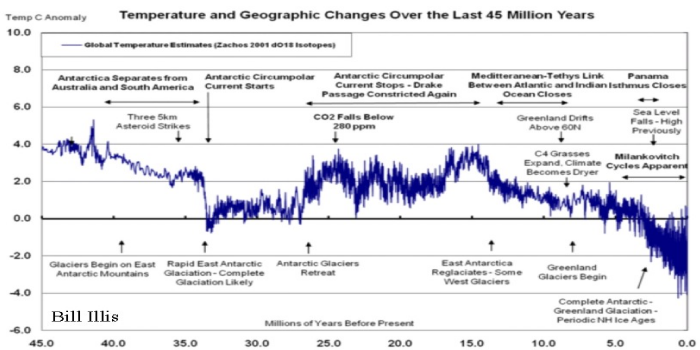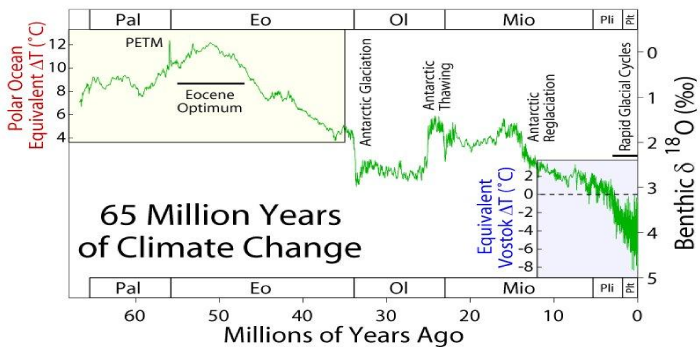
How much global warming is dangerous?
The United Nation’s IPCC and other climate alarmists say all hell will break loose if the global temperature rises more than an additional 2 C (3.6 F). That number, by the way, is purely arbitrary with no basis in science. It also ignores Earth’s geologic history which shows that for most of the time global temperatures have been much warmer than now. Let’s look back at a time when global temperatures are estimated to have been as much as 34 F warmer than they are now. Hell didn’t break loose then.
The Paleocene-Eocene Thermal Maximum (PETM) was a temperature spike that happened about 55 million years ago. The preceding Cretaceous and early Tertiary periods where hot and steamy with average global temperatures estimated to be at least 10 C (18 F) warmer than now. Atmospheric carbon dioxide was estimated to be at least three times higher than now. Life was abundant and flourishing in part because of fertilization by carbon dioxide – plant food. The Cretaceous has been described as both a “hot house” and as a “garden of Eden.” There was no ice at the poles.
The PETM temperature spike caused global temperatures to get even warmer. Drill core data from deep-sea sediments in the Atlantic and Pacific oceans suggested a rapid rise (geologically rapid, i.e., 10,000 years) of 5 C to 9 C (9-16 F) higher than the existing temperature prior to the event, that is, to as much as 34 F warmer than now. Global temperature stayed at this elevated level for about 100,000 years, then rapidly cooled back to the prevailing normal temperature and then cooled even more. Atmospheric carbon dioxide is estimated to have risen from the prevailing 1,000 ppm to about 1,700 ppm, more than four times higher than today. Life was robust.
The cause of the temperature spike is controversial. Theories include volcanic eruption and massive forest fires that could have put large quantities of carbon dioxide into the atmosphere, changes in ocean circulation, and evolution of methane into the atmosphere. Recent research shows that the amount of carbon dioxide in the atmosphere was insufficient to cause all of the temperature rise (Zeebe et al.), and that warming began before the rise of carbon dioxide (Secord et al.).
The current favored hypothesis is that methane (CH4) was the primary cause of temperature rise. Methane is a powerful greenhouse gas and its evolution into the atmosphere could have initiated warming. Carbon dioxide is formed by reaction of methane with oxygen. Under warming conditions carbon dioxide also exsolves from the ocean. Evidence suggests that warming happened in several pulses. However, once all the methane was destroyed by reaction with oxygen, the planet cooled in spite of there being copious carbon dioxide in the atmosphere. This shows that the weak warming effect of carbon dioxide is easily overcome by other natural forces. It also shows that even with carbon dioxide concentration in the atmosphere four times what it is now, “runaway” global warming is impossible on our water world.
Where did the methane come from? Let me set the scene. At the time of PETM, the continents were not in their present location. The North Atlantic was just beginning to open to the Arctic Ocean; this could have changed the ocean circulation and hence the sea temperature. Volcanism and other tectonic disturbances were very active as the Atlantic opened.
There are two potential sources for methane. One is methane hydrates sequestered in ocean sediments. Methane hydrates are ice-like compounds of water and methane formed under cold deep sea temperatures and pressure. Either a change in temperature or a change in pressure would release the methane.
The second, and perhaps more likely source, involves volcanism and organic methane sequestered in deep sea sediments, similar to the oil shale deposits now being explored. As noted in Geotimes (October 2006), research in the Norwegian sea found thousands of hydrothermal vent complexes that date to the Paleocene-Eocene boundary. As methane-bearing sediments were subducted deeper and deeper, they came into contact with hot magma from the mantle. This can cause explosive events and rapid release of methane. This scenario is supported by the high ratio of Carbon-12 to Carbon-13, indicating microbic generated methane, found at the PETM event.
With rapid warming came both death and opportunity. Mammal diversity and range exploded as did that for terrestrial plants. The North American horse first appeared at this time. At the same time, however, deep-dwelling ocean fauna suffered a rapid extinction.
Although the global temperature dropped rapidly after PETM once the methane was used up, another warming spike happened about 40 million years ago in mid-Eocene time, possibly due to a similar cause. But afterwards another sharp cooling trend began and by 34 million years ago ice began to form in Antarctica. Global temperatures and atmospheric carbon dioxide have been dropping ever since (see graphs below). We are presently in an interglacial period of an ice age that began about three million years ago.
Life on Earth made it through the hot Cretaceous and PETM temperature spike, so it is hard to see how a rise of only 2 C (3.6 F), if it actually happened, would make much difference. Earth and its life are resilient.
The IPCC’s arbitrary 2 C (3.6 F) “tipping point” has no basis in science. It is just a phantom menace designed to control the world’s economy by requiring reduction of carbon dioxide emissions and hence energy use. As H.L. Mencken wrote: “The whole aim of practical politics is to keep the
populace alarmed – and hence clamorous to be led to safety – by menacing it with an endless series of hobgoblins, all of them imaginary.”
Below are two graphs, the first showing temperature history of the past 65 million years; the second showing the past 45 million years with more detail on geographic/geologic events. Notice that during almost all of that time, Earth was much warmer than it is now.
References:
Ross Secord, Philip D. Gingerich, Kyger C. Lohmann & Kenneth G. MacLeod, 2010, Continental warming preceding the Palaeocene–Eocene thermal maximum, Nature 467,955–958.
Richard E. Zeebe, James C. Zachos & Gerald R. Dickens, 2009, Carbon dioxide forcing alone insufficient to explain Palaeocene–Eocene Thermal Maximum warming, Nature Geoscience 2, 576 – 580 (2009)
See also:
A Brief Geologic History of Arizona Chapter 1 Precambrian
A Brief Geologic History of Arizona Chapter 2 Cambrian and Ordovician time
A Brief Geologic History of Arizona Chapter 3 Silurian to Permian
Arizona Geological History Chapter 4: Triassic Period
A brief geologic history of Arizona Chapter 5: Jurassic Time
A brief geologic history of Arizona Chapter 6: Cretaceous Time
A brief geologic history of Arizona Chapter 7, the Cenozoic Era


